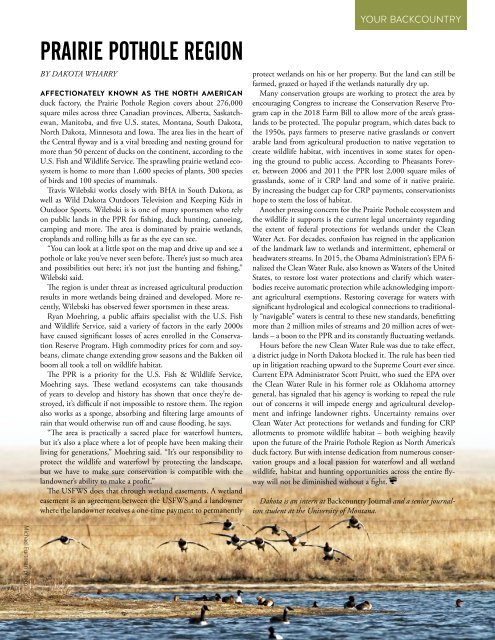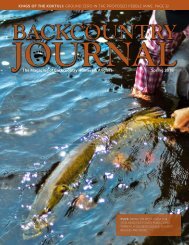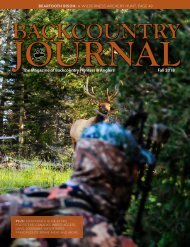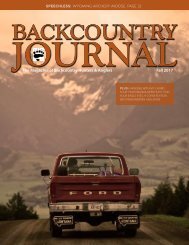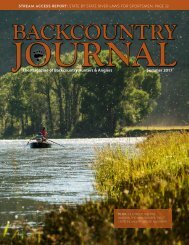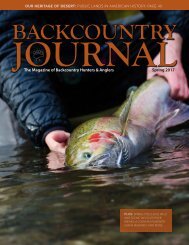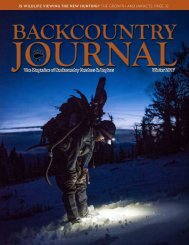BCJ_WINTER18 Digital Edition
Create successful ePaper yourself
Turn your PDF publications into a flip-book with our unique Google optimized e-Paper software.
YOUR BACKCOUNTRY<br />
PRAIRIE POTHOLE REGION<br />
BY DAKOTA WHARRY<br />
AFFECTIONATELY KNOWN AS THE NORTH AMERICAN<br />
duck factory, the Prairie Pothole Region covers about 276,000<br />
square miles across three Canadian provinces, Alberta, Saskatchewan,<br />
Manitoba, and five U.S. states, Montana, South Dakota,<br />
North Dakota, Minnesota and Iowa. The area lies in the heart of<br />
the Central flyway and is a vital breeding and nesting ground for<br />
more than 50 percent of ducks on the continent, according to the<br />
U.S. Fish and Wildlife Service. The sprawling prairie wetland ecosystem<br />
is home to more than 1,600 species of plants, 300 species<br />
of birds and 100 species of mammals.<br />
Travis Wilebski works closely with BHA in South Dakota, as<br />
well as Wild Dakota Outdoors Television and Keeping Kids in<br />
Outdoor Sports. Wilebski is is one of many sportsmen who rely<br />
on public lands in the PPR for fishing, duck hunting, canoeing,<br />
camping and more. The area is dominated by prairie wetlands,<br />
croplands and rolling hills as far as the eye can see.<br />
“You can look at a little spot on the map and drive up and see a<br />
pothole or lake you’ve never seen before. There’s just so much area<br />
and possibilities out here; it’s not just the hunting and fishing,”<br />
Wilebski said.<br />
The region is under threat as increased agricultural production<br />
results in more wetlands being drained and developed. More recently,<br />
Wilebski has observed fewer sportsmen in these areas.<br />
Ryan Moehring, a public affairs specialist with the U.S. Fish<br />
and Wildlife Service, said a variety of factors in the early 2000s<br />
have caused significant losses of acres enrolled in the Conservation<br />
Reserve Program. High commodity prices for corn and soybeans,<br />
climate change extending grow seasons and the Bakken oil<br />
boom all took a toll on wildlife habitat.<br />
The PPR is a priority for the U.S. Fish & Wildlife Service,<br />
Moehring says. These wetland ecosystems can take thousands<br />
of years to develop and history has shown that once they’re destroyed,<br />
it’s difficult if not impossible to restore them. The region<br />
also works as a sponge, absorbing and filtering large amounts of<br />
rain that would otherwise run off and cause flooding, he says.<br />
“The area is practically a sacred place for waterfowl hunters,<br />
but it’s also a place where a lot of people have been making their<br />
living for generations,” Moehring said. “It’s our responsibility to<br />
protect the wildlife and waterfowl by protecting the landscape,<br />
but we have to make sure conservation is compatible with the<br />
landowner’s ability to make a profit.”<br />
The USFWS does that through wetland easements. A wetland<br />
easement is an agreement between the USFWS and a landowner<br />
where the landowner receives a one-time payment to permanently<br />
protect wetlands on his or her property. But the land can still be<br />
farmed, grazed or hayed if the wetlands naturally dry up.<br />
Many conservation groups are working to protect the area by<br />
encouraging Congress to increase the Conservation Reserve Program<br />
cap in the 2018 Farm Bill to allow more of the area’s grasslands<br />
to be protected. The popular program, which dates back to<br />
the 1950s, pays farmers to preserve native grasslands or convert<br />
arable land from agricultural production to native vegetation to<br />
create wildlife habitat, with incentives in some states for opening<br />
the ground to public access. According to Pheasants Forever,<br />
between 2006 and 2011 the PPR lost 2,000 square miles of<br />
grasslands, some of it CRP land and some of it native prairie.<br />
By increasing the budget cap for CRP payments, conservationists<br />
hope to stem the loss of habitat.<br />
Another pressing concern for the Prairie Pothole ecosystem and<br />
the wildlife it supports is the current legal uncertainty regarding<br />
the extent of federal protections for wetlands under the Clean<br />
Water Act. For decades, confusion has reigned in the application<br />
of the landmark law to wetlands and intermittent, ephemeral or<br />
headwaters streams. In 2015, the Obama Administration’s EPA finalized<br />
the Clean Water Rule, also known as Waters of the United<br />
States, to restore lost water protections and clarify which waterbodies<br />
receive automatic protection while acknowledging important<br />
agricultural exemptions. Restoring coverage for waters with<br />
significant hydrological and ecological connections to traditionally<br />
“navigable” waters is central to these new standards, benefitting<br />
more than 2 million miles of streams and 20 million acres of wetlands<br />
– a boon to the PPR and its constantly fluctuating wetlands.<br />
Hours before the new Clean Water Rule was due to take effect,<br />
a district judge in North Dakota blocked it. The rule has been tied<br />
up in litigation reaching upward to the Supreme Court ever since.<br />
Current EPA Administrator Scott Pruitt, who sued the EPA over<br />
the Clean Water Rule in his former role as Oklahoma attorney<br />
general, has signaled that his agency is working to repeal the rule<br />
out of concerns it will impede energy and agricultural development<br />
and infringe landowner rights. Uncertainty remains over<br />
Clean Water Act protections for wetlands and funding for CRP<br />
allotments to promote wildlife habitat – both weighing heavily<br />
upon the future of the Prairie Pothole Region as North America’s<br />
duck factory. But with intense dedication from numerous conservation<br />
groups and a local passion for waterfowl and all wetland<br />
wildlife, habitat and hunting opportunities across the entire flyway<br />
will not be diminished without a fight.<br />
Dakota is an intern at Backcountry Journal and a senior journalism<br />
student at the University of Montana.<br />
Michael Furtman photo<br />
WINTER 2018 BACKCOUNTRY JOURNAL | 5


